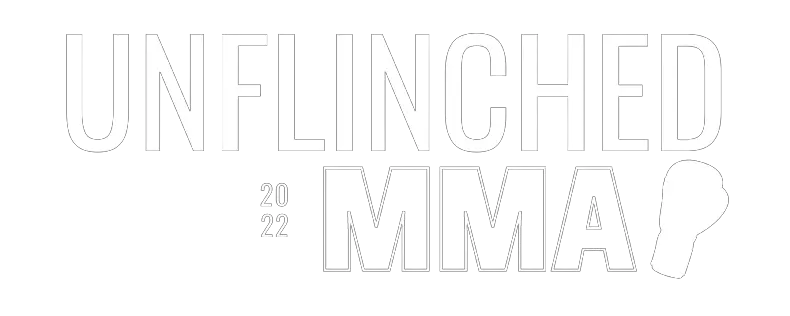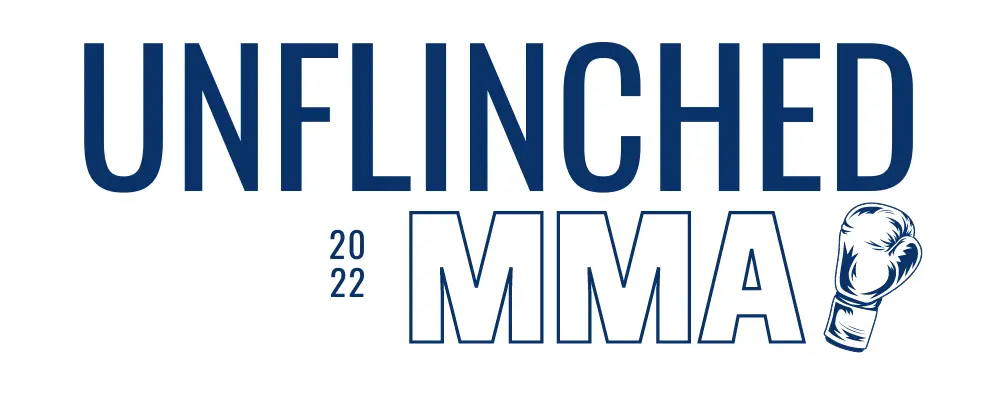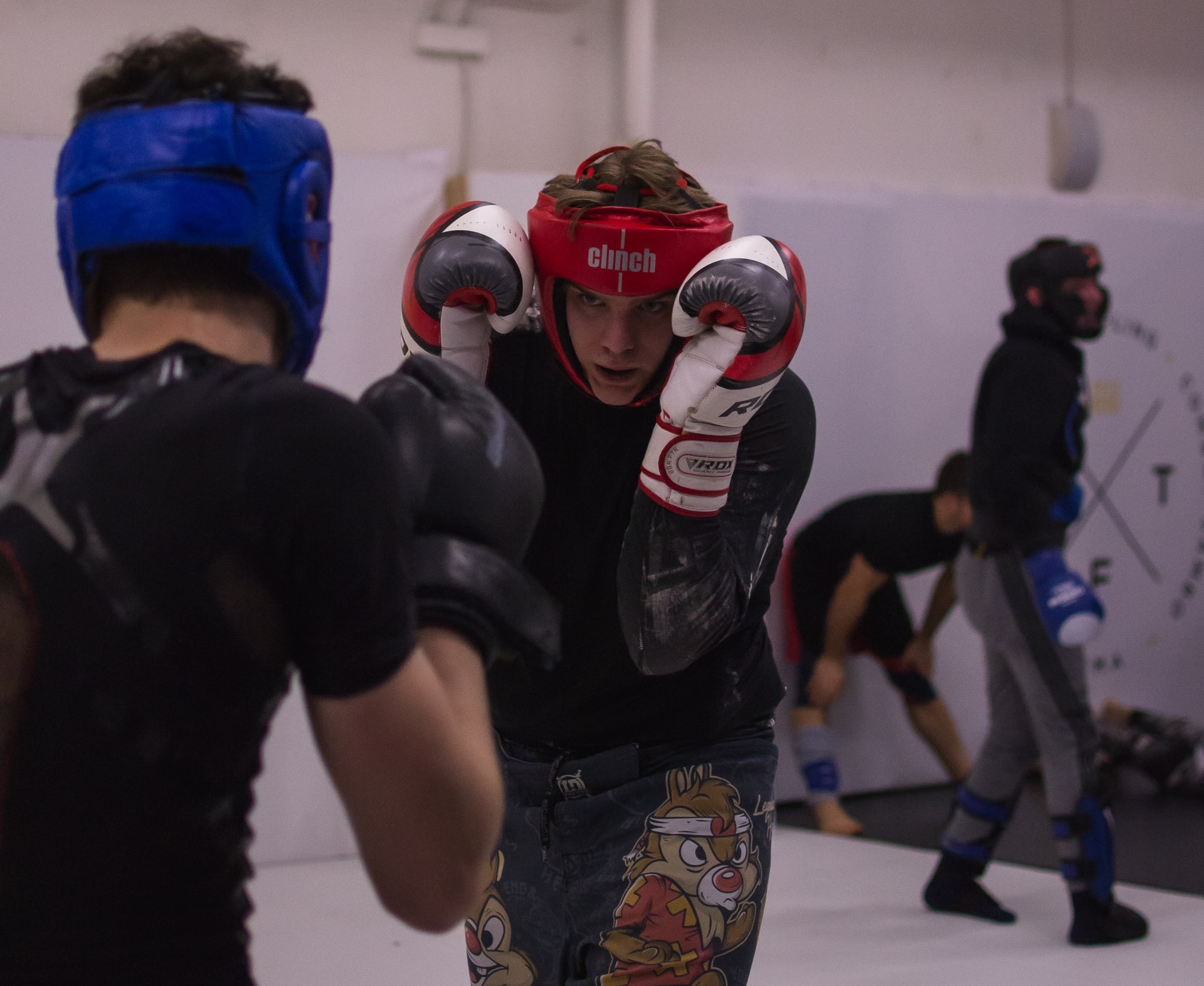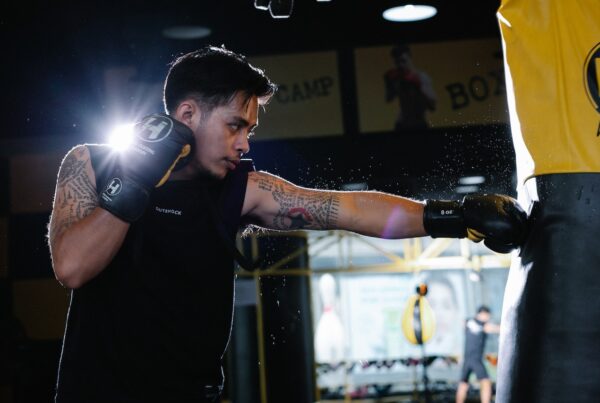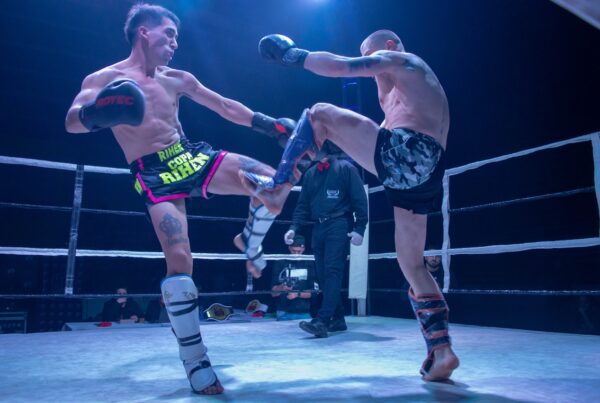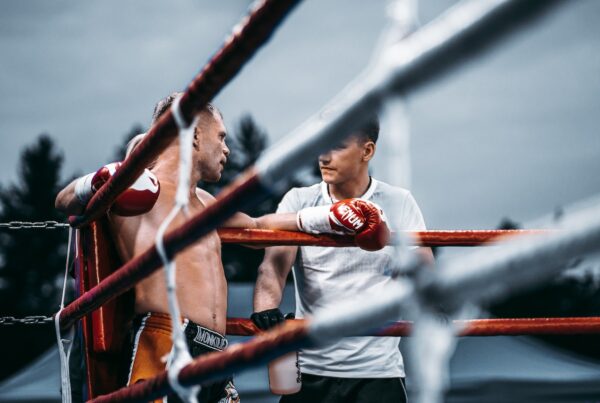MMA (mixed martial arts) is a physically and mentally demanding sport that can be learned at home. Whether you’re a beginner or have some experience, these 10 steps will help you learn MMA at home.
I personally enjoy going to a gym much more and training with my peers. But with Covid-19, many gyms were closed – forcing us to train at home and be creative! During those times, I was figuring out how to train MMA at home (which is why this list is highly relevant).
In this article, I focus on MMA training for beginners. This list is what I would personally do if I had to start learning MMA from the beginning at home (yes, it’s possible). It’s all about setting up space, getting the right equipment and knowing what to learn step-by-step.
Table of Contents
1. Set Up The Required Space At Home
There’s no way to learn effectively if you don’t have a space where you can practice regularly. To get started, try setting up a room in your house specifically for MMA training.
This can be as simple as creating a makeshift ring in your living room or basement, or investing in an actual MMA training area like the ones available from companies like Xtreme Couture and 10th Planet Jiu-Jitsu.
Your MMA training space at home doesn’t have to be that big but at least 2m by 1.5m (6.5ft by 5ft). Of course, the bigger the better because the additional space allows you to move more freely and place more equipment like a punching bag or speed bag.
Next step is to get the necessary equipment for your training. As a beginner, you don’t need that much – so don’t worry about breaking the bank.
2. Get The Right Equipment
Essential equipment for MMA training at home:
- MMA Mat. A quality MMA mat will ensure that you are comfortable while training and fighting. Look for one with a heavy bottom so that it will not move during training sessions.
- Hand wrap. Hand wrap is essential when you are practising MMA with gloves on. Hand wrap provides support to your wrists and provides much comfort when wearing gloves. And not to mention, hand wrap can be washed much more easily than gloves – so let your hand wrap absorb your sweat instead of your gloves.
- MMA gloves. MMA fighters wear gloves to protect their hands and fists from injuries. If you are focused on MMA, then get an MMA glove. Getting a boxing glove for MMA could be too restrictive because it’s too thickly padded and your fingers are not free.
- Speed bag or punching bag. A speed bag is a training tool that can be used for a variety of purposes such as punching and evading. It’s much smaller than punching bags and will take less space. On the other hand, punching bags are a much more versatile tool that allows you to practice punching, kicking and even takedowns. If you have the space and budget, then go for a punching bag instead of a speed bag.
- Agility ladder. Agility ladder is essential for practising your footwork and rhythm. It’s relatively inexpensive and does not require much space at all. I personally like training with an agility ladder and have improved my footwork considerably.
- Full body mirror. When practising MMA (or any martial arts), it’s important to get the form right. For this, you need to pay attention to both the instructor and yourself. If you are learning from online videos, then pay attention to how the instructor moves his / her shoulders, torso and feet when striking. Similarly, pay attention to yourself using a mirror. You must achieve the same form as your instructor to be effective.
Related article: The Ultimate Guide To Boxing Gloves Size For All Factors
Optional equipment for MMA training at home:
- Head gear. Headgear is important for protecting your head during sparring. Look for something that fits well, has good ventilation, and shields your ears from blows.
- Mouth guard. Mouth guard is important if you are going to spar with a partner- they are inserted into the mouth before a fight to protect against concussions, tooth fractures, and other oral injuries. Mouth guards are made of a variety of materials, including plastic or silicone – you cannot go wrong with any of them.
- Kicking shields. Kicking shields are used to practice kicking techniques without any repercussions. They come in different sizes, shapes, and weights, so you can find one that is perfect for your needs.
Once you’ve got the space and equipment set up, it’s time to start training. One of the best ways to learn is by watching professional fighters train and then trying to emulate their techniques. You can find UFC and other professional fights on YouTube, cable TV or online streaming services like UFC Fight Pass.
You could also enroll into online MMA classes or even leverage technologies like VR headset for a more immersive training. I will talk more about the actual training later.
4. Learn Basic Striking
Basic striking techniques in MMA include punches, kicks, knees and elbow strikes. Each has its own advantages and disadvantages, so it’s important to learn the right one for the situation.
For example, kicks are great for hitting opponents from a distance, but they’re less effective against opponents who are facing you straight on. Punches have the advantage of being able to hit opponents at close distance, while still being less susceptible to counter attacks.
As a beginner to MMA, you should learn the basics of punches first – this includes jab, cross, uppercut and hook. These punches. techniques are the most basic and you could learn them from online sources like YouTube. Focus on getting the right form instead of the power. Once you get the right form, your punches will automatically be stronger and faster.
To throw punches at the right form, you need to make sure your shoulders and torso are also rotated. Most beginners throw punches only using their arms and elbow – this is slow and not powerful (and definitely not the right form).
Once you get the right form for throwing punches, then you could proceed with kicks, knee strikes and elbow strikes (in that order). Similar to punching, focus on the right forms when it comes to kicks, knees and elbows – ensure your feet, shoulder and torso are rotated. Don’t focus on the power just yet.
After learning through basic striking, you should be familiar with the terminologies around MMA – and this is important when communicating to your peers. As you learn different techniques, you are bound to learn more terminologies. Don’t worry about memorising the terminologies but don’t neglect them either.
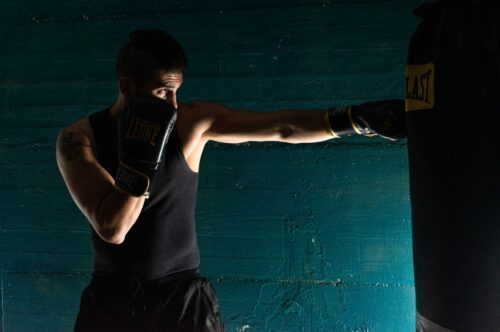
5. Learn Basic Takedown & Grappling
Takedown and grappling techniques like armbar, guillotine chokes and triangle chokes are important in MMA because they are extremely effective and can even decide the outcome of a fight early on. If you are not interested in takedowns and grappling, at least learn how to defend yourself against such attacks.
Takedowns and grappling attacks are especially important in today’s MMA because of how successful BJJ practitioners are in MMA matches like UFC. An MMA practitioner who does not practise grappling will not find much success in MMA (both in matches and in real world self-defence scenarios).
It’s much harder to practice takedowns and grappling at home – generally, you need a partner. I recommend going to YouTube to learn some basic home drills for BJJ. If you are completely alone, you could use your punching bag to practice takedown and grappling (even pillows would help).
At some point, you will need to go to a gym to practice takedowns and grappling. If you are learning MMA just for self defence and workout, then I guess going to the gym is not really necessary. Sticking with stand-up striking should be enough.
On the other hand, if you are serious about learning MMA and want to participate in matches, then you eventually must go to a gym to learn takedown, grappling and submission moves such as armbar, triangle chokehold etc. This requires years of practice and training before they can be executed safely in a real fight situation – practising alone at home won’t be enough.
6. Learn Basic Combos
Combos are extremely common in any martial arts (especially MMA). Practising basic combos allow you to get into a rhythm and make practice enjoyable – as well as effective in fights.
Basic combos in MMA include:
- Jab — Jab — Cross
- Jab — Cross — Round Kick
- Jab — Cross — Left Hook — Low Kick.
- Jab — Jab — Cross — Left Body Shot — Low Kick
You are free to create your combos or use the basic common combos. It is important to note that your combos should not be predictable. Being predictable is extremely dangerous – because you will be susceptible to counter attacks that could instantly result in a KO.
Get creative on your combos and take inspiration from your most popular fighters.
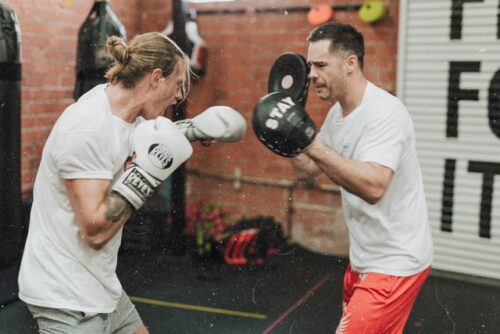
As a beginner, focus on basic combos first and then work on creating your own.
7. Learn Basic Defence
Once you know the basics of striking, you’ll need to learn how to defend yourself against different types of attacks.
There are dozens of different MMA techniques out there, but some of the most common ones include takedowns, chokes, and arm bars. Learning how to defend against these attacks is essential if you want to stay safe in a fight.
Here are the most common defence for beginners to learn:
- Keep your hands up (meaning, your hands are always up to protect your face, chin and jaw – as they are the weakest points).
- Use your shin to defend against kicks. meaning, keep your leg up to protect your stomach against kicks. You could also rotate your shin to parry against enemy kicks.
- Use your knee to defend against takedowns. To launch a takedown attack, your opponent will most likely duck and go for your waist. Defend against this attack by keeping your knee up.
- Don’t expose your neck while grappling. While on the ground, it’s important to keep your neck protected. Once an opponent gets a hold of your neck, it could take as less as 5 seconds to make you unconscious with a blood choke.
These basic defences can easily be practised and learned through online sources like YouTube videos. So nothing to worry here, you can practise this by yourself at home.
8. Learn About Counters
Counter is when you predict your opponent’s strike, evade it and at the same time launch a counter attack. Thus the name ‘counter’. Counter is extremely effective because your opponent does not expect it and you are using their punching weight against them.
Counter is an advanced technique that takes years to practise. Similar to grappling, counters are usually practised through sparring with a partner. You may have to go to a gym to practise counters. But that said, you can still incorporate counters and feints into your workout routine and shadow boxing.
Counters cannot be learned through a textbook or course. You need to experience the fights and develop a feel for them.
Related article: 8 Tips To Predict Incoming Punches: Where To Focus In Boxing
9. Learn About Footwork & Rhythm
Footwork is an important part of any MMA fighter’s arsenal, as it allows them to move around the octagon more efficiently and defend against their opponent’s attacks. In order to incorporate footwork into your training, be sure to practice different types of footwork drills.
One drill that focuses on rhythm is called “The Scissor Sweep.” This drill involves two fighters circling each other, with one fighter using a scissor sweep move to take the other down. To learn how to do this move properly, practice timing your sweep so that you land before your opponent can counterattack.
Rhythm is another key factor in MMA fighting. To be successful, you need to know when to attack and when to defend. Practice learning different combinations of punches and kicks so that you can start landing the strikes that will defeat your opponents. Additionally, focus on practising moving around the octagon while keeping your balance – these skills will help you avoid being tackled or pushed out of the ring.
You can find plenty of YouTube videos on MMA footwork. This could be boxing, footwork, kickboxing or even karate. A great footwork separates the novice martial artists with the experienced ones. To the naked eye, poor footwork is what causes people to look ‘stiff’.
10. Don’t Neglect Strength, Cardio and Nutrition
Cardio is Key For Mixed Martial Arts Training One of the most important things you need for MMA training is good cardio. If you don’t have good cardiovascular fitness, your workouts will be ineffective and you’ll end up injuring yourself more often.
To improve your cardio fitness, try incorporating some regular aerobic exercise into your routine. This could include running, biking, elliptical training, or even using an indoor trainer at home. At least practise your cardio three times a week. Without good cardio, all your MMA techniques will go to waste because you have no energy to use them (especially later in the rounds).
Strength Training is also Essential for MMA training. Muscles help protect your joints and help deliver power when you strike opponents with punches and kicks. Strengthening your muscles will also help reduce the chance of injury in MMA fights.
To increase your strength and muscle mass, try working out with weights at a gym or using resistance machines at home. You can also try high-intensity interval training (HIIT) if you want to maximise results in a short amount of time.
And lastly, Just like any other physical activity, MMA training requires proper nutrition in order to be effective and safe. If you don’t eat enough calories and carbohydrates during training sessions, you’ll end up feeling tired and weak later on in the day.
11. Set Up a Training Schedule
One of the most important things you can do to improve your MMA skills is to set up a training schedule. By splitting your training into manageable sessions, you will be able to make consistent progress. Here are some tips for setting up a successful MMA training schedule:
- Decide what type of training you want to accomplish. If you only want to improve your striking skills, focus on sparring and drilling techniques regularly. If you are looking to improve your grappling abilities, focus on conditioning and learning submission holds.
- Determine how many days per week you will be able to train. If you are available six days per week, try to divide your time evenly among the five days. If you only have four days per week available, try working out three times per week instead of twice.
- Choose a workout routine that is challenging but realistic for your skill level and body composition. Do not overtrain; excessive fatigue will hinder your progress rather than help it forward. Try not to exceed two hours in total workout time each day except for conditioning workouts that last 30 minutes or less in duration.
12. Take Regular Breaks
MMA is a physical and mental sport that can be very demanding on the body. Taking regular breaks between rounds and training sessions can help to avoid overtraining, which can lead to injury. Additionally, it is important to allow your mind and body time to rest in order to maintain optimal performance.
13. Watch a lot of fights
In order to really learn MMA, it is important to watch a lot of fights and get inspiration. There are many online sources where you can watch MMA fights for free, or you can purchase video recordings of some of the best fights available. Watching a lot of fights will give you a better understanding of how the sport works and will help you improve your skills as a fighter.
Watching replays of fights is a very common thing to do – especially before a match. You need to understand your opponent’s strengths and weaknesses to create a fighting strategy.
If you are not planning to go into MMA tournaments, then at least watch the fights to get inspiration and learn. Focus on their combos and techniques – if it works for them, it should work for you too. What I find most useful are the YouTube channels that do analysis of fights. These channels will break down a fight into understandable info which you could learn from.
For example, Daniel Cormier (MMA legend) analysis fights on ESPN. You can watch some if from YouTube like this one. It’s very useful for me to learn.
14. Stay Calm and Patient
MMA is a physical and mental sport that can be very demanding on the body. It is important to be patient while learning this sport, as it may take some time to learn the proper techniques and develop your skills. Do not get discouraged if you do not progress quickly; with patience and practice, you will eventually become a better fighter.
It is important to stay calm and patient when learning MMA at home. Training in a controlled environment can help you to avoid injury and focus on the techniques, rather than the physical outcome of the match.
It is also important to be patient because learning new techniques takes time, and it can be frustrating if you feel like you are not making progress. Remain positive and allow your training partner or coach to guide you through each step of the learning process.
Can You Learn MMA From YouTube?
There is no doubt that MMA can be learned from YouTube. However, it is important to be aware of the quality and accuracy of the videos that you watch. Some amateur MMA fighters have developed their skills without proper training and have used inaccurate techniques in their videos. It is important to learn only from YouTube channels that are well established (Eg. High subscriber count or view count).
Here are some YouTube channels that I find useful and offer high quality MMA training videos:
- fightTIPS – (MMA related)
- Tony Jeffries – (Boxing related)
- Knight JiuJitsu – (BJJ Related)
Can You Learn MMA Through VR At Home?
There is a growing trend of people wanting to learn self-defence techniques outside of the traditional gym setting. Virtual reality (VR) has been shown to be an effective way to teach new skills, and mixed martial arts (MMA) is one such skill that can be learned through VR.
The main benefit of learning MMA in VR is that it allows you to practice the skills in a safe and controlled environment. You can also use VR as a training tool to help improve your reflexes and timing. Additionally, by practising in VR you can develop endurance and coordination, which are essential for MMA training.
I recently bought a VR headset (Meta Quest 2) and bought some boxing games like “Thrill Of The Fight” – it’s quite cheap at $10 and incredibly fun. I was able to workout at home using this game and it was surprisingly effective. I was drenched in sweat after about 10 minutes of game play. If you have a VR game, I recommend checking out this game (not affiliated).
If you are looking for effective ways to workout from home, then I suggest looking into getting a VR headset. There are lots of games and workout-related content that you could follow along with very little space from home.

Thrill of the fight (boxing VR game)

